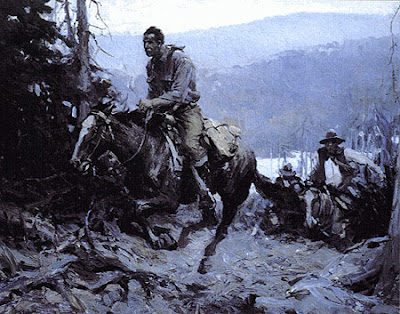STATE OF TEXAS
OFFICE OF THE GOVERNOR
GEORGE W. BUSH
GOVERNOR
MEMORANDUM
TO: Hard Working Staff Members
FROM: Governor
DATE: April 3, 1995I thought I would share with you a recent bit of Texas history which epitomizes our mission.
My very close personal friend from Midland, Joe. J. O'Neill, III, recently loaned me a portrait entitled "A Charge to Keep" by W.H.D. Koerner. This beautiful painting will hang on my wall for the next four years.
The reason I bring this up is that the painting is based upon the Charles Wesley hymn "A Charge to Keep I Have". I am particularly impressed by the second verse of this hymn. The second verse goes like this:
"To serve the present age, my calling to fulfill;
O may it all my powers engage to do my Master's will"This is our mission. This verse captures our spirit.
Joe was inspired to make this generous loan during the church service preceding the inaugural ceremonies. It was in this church service when we sang the hymn "A Charge to Keep I Have".
When you come into my office, please take a look at the beautiful painting of a horseman determinedly charging up what appears to be a steep and rough trail. This is us. What adds complete life to the painting for me is the message of Charles Wesley that we serve One greater than ourselves.
Thank you for your hard work. Thank you for your service to our State. God Bless Texas!
Weisberg notes, "Bush identified with the lead rider, whom he took to be a kind of Christian cowboy, an embodiment of indomitable vigor, courage, and moral clarity."
[Special note: The syntax of the hymn explains Bush's peculiar way of speaking. He thinks "O may it all my powers engage to do my Masters will" is a properly constructed sentence.]
When elected president, Bush took the painting with him to the White House, and hung it in the Oval Office, adding to and expanding the tale of the painting; in 2004, Bush said:
There's a painting on the wall in the Oval Office that shows a horseman charging up a steep cliff, and there are at least two other horsemen following. It's a Western scene by a guy named W.H.S. Koerner called "A Charge to Keep." It's on loan, by the way, from a guy named Joe O'Neill in Midland, Texas. He was the person, he and his wife Jan, introduced — reintroduced me and Laura in his backyard in July of 1977. Four months later, we were married. So he's got a — I'm a decision-maker and I can make good decisions. (Applause.)
And so we sang this hymn — this is a long story trying to get to your answer. (Laughter.) This is not a filibuster. (Laughter.) That's a Senate term — particularly on good judges. (Applause.) The hymn was sung at my first inaugural church service as governor. Laura and I are Methodists. One of the Wesley boys wrote the hymn. The painting is based upon the hymn called, "A Charge to Keep." I have. The hymn talks about serving something greater than yourself in life. I — which I try to do, as best as I possibly can.
Bush takes special pride in pointing out two paintings he has hung that highlight his motives and legacy. He consciously placed these pictures in the Oval Office at the beginning of his tenure to serve as prescient cultural markers. "The Texas paintings are on the wall because that's where I'm from and where I'm going," he says.
One of them, by little-known painter and illustrator William Henry Dethlef Koerner, titled "A Charge to Keep," depicts a hatless cowboy followed by two other riders galloping up a hill. Their faces are intent as they pursue some quarry in the distance that cannot be seen by others. Or are they being chased? "I love it," Bush said, further explaining his intimate feeling for the painting to reporters and editors of the Washington Times, a conservative newspaper. He offered his interpretation: "He's a determined horseman, a very difficult trail. And you know at least two people are following him, and maybe a thousand." Bush added that the painting is "based" on an old hymn. "And the hymn talks about serving the Almighty. So it speaks to me personally." When he was governor of Texas and the painting hung in his office, Bush wrote a note of explanation to his staff: "This is us."
So, there's the set-up. Almost thirteen years ago, Bush receives a painting and is taken in by it, seeing in the brushstrokes a reflection of himself. This, he decides, is what I am. This is my mission. This striking horseman epitomizes my own Texas spirit, my commitment to God and country. I will be that horseman, I will take his mission on to be my own, to become my calling to fulfill.
The punch line: Koerner did not paint a rugged horseman riding to spread the word of god. Koerner painted the man as a horse thief fleeing a lynch mob.
The artist, W.H.D. Koerner, executed it to illustrate a Western short story entitled "The Slipper Tongue," published in The Saturday Evening Post in 1916. The story is about a smooth-talking horse thief who is caught, and then escapes a lynch mob in the Sand Hills of Nebraska. The illustration depicts the thief fleeing his captors. In the magazine, the illustration bears the caption: "Had His Start Been Fifteen Minutes Longer He Would Not Have Been Caught."
That explains a lot.
- The Blog from Another Dimension: The Inspiration -



No comments:
Post a Comment